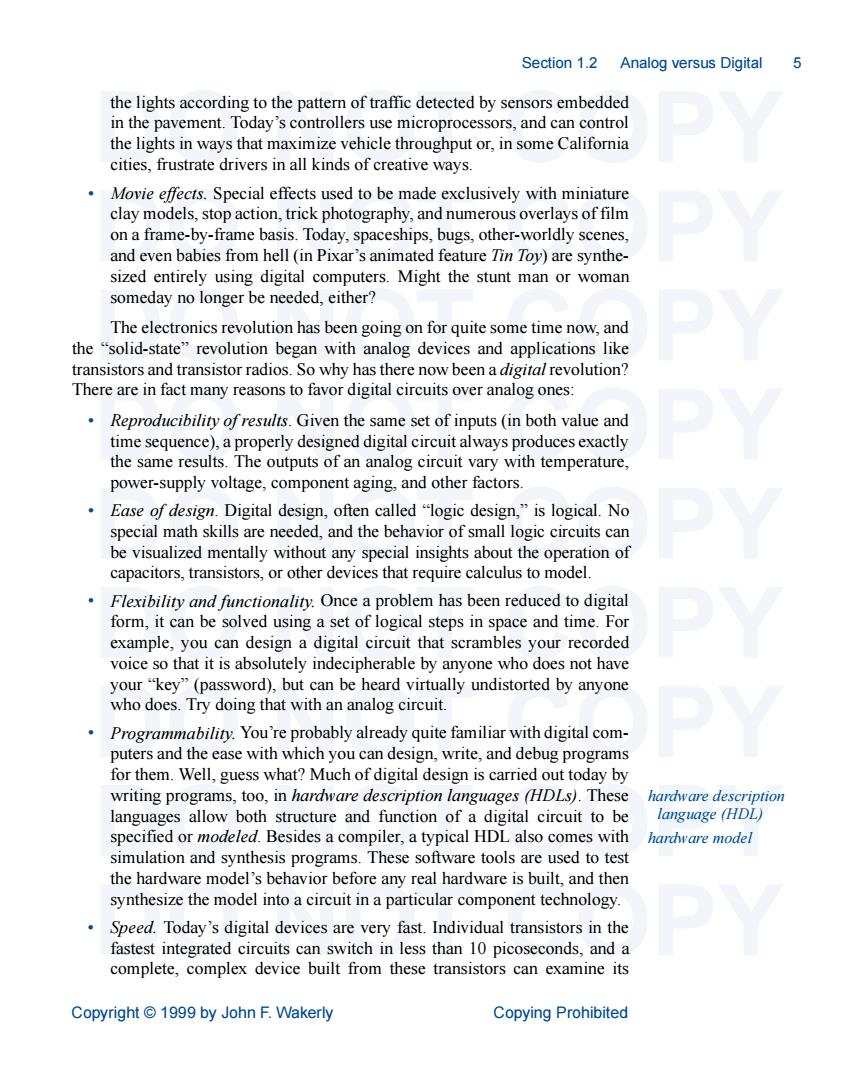正在加载图片...

Section1.2 Analog versus Digital 5 the lights according to the pattern of traffic detected by sensors embedded in the pavement.Today's controllers use microprocessors,and can control the lights in ways that maximize vehicle throughput or,in some California cities,frustrate drivers in all kinds of creative ways. Movie effects.Special effects used to be made exclusively with miniature clay models,stop action,trick photography,and numerous overlays of film on a frame-by-frame basis.Today,spaceships,bugs,other-worldly scenes and even babies from hell(in Pixar's animated feature Tin Toy)are synthe- sized entirely using digital computers.Might the stunt man or woman someday no longer be needed,either? The electronics revolution has been going on for quite some time now,and the "solid-state"revolution began with analog devices and applications like transistors and transistor radios.So why has there now been a digital revolution? There are in fact many reasons to favor digita: Reproducibility ofresults.Given the same set of inputs (in both value and power-supply voltage,component aging,and other factors. Ease ofdesign.Digital design,often called"logic design,"is logical.No special math skills are needed,and the behavior of small logic circuits can capacitors,transistors,or other devices that require calculus to model Flexibility and functionality.Once a problem has been reduced to digital form,it can be solved using a set of logical steps in space and time.For example,you can design a digital circuit that scrambles your recorded voice so that it is absolutely indecipherable by anyone who does not have your"key"(password),but can be heard virtually undistorted by anyone who does.Try doing that with an analog circuit. Progy You're probably aready quite familiar with digital com puters which you.and ebug programs for them.Well,guess what?Much of digital design is carried out today by writing programs.too in hardhvare description languages (HDLs)These languages allow both structure and function of specified or modeled.Besides a compiler,a typical HDL come hardware model simulation and synthesis programs.These software tools are used to test the hardware model's behavior before any real hardware is built,and then synthesize the model into a circuit in a particular component technology. Speed.Today's digital devices are very fast.Individual transistors in the fastest integrated circuits can switch in less than 10 picoseconds,and a complete,complex device built from these transistors can examine its Copyright 1999 by John F.Wakerly Copying ProhibitedSection 1.2 Analog versus Digital 5 DO NOT COPY DO NOT COPY DO NOT COPY DO NOT COPY DO NOT COPY DO NOT COPY DO NOT COPY DO NOT COPY DO NOT COPY Copyright © 1999 by John F. Wakerly Copying Prohibited the lights according to the pattern of traffic detected by sensors embedded in the pavement. Today’s controllers use microprocessors, and can control the lights in ways that maximize vehicle throughput or, in some California cities, frustrate drivers in all kinds of creative ways. • Movie effects. Special effects used to be made exclusively with miniature clay models, stop action, trick photography, and numerous overlays of film on a frame-by-frame basis. Today, spaceships, bugs, other-worldly scenes, and even babies from hell (in Pixar’s animated feature Tin Toy) are synthesized entirely using digital computers. Might the stunt man or woman someday no longer be needed, either? The electronics revolution has been going on for quite some time now, and the “solid-state” revolution began with analog devices and applications like transistors and transistor radios. So why has there now been a digital revolution? There are in fact many reasons to favor digital circuits over analog ones: • Reproducibility of results. Given the same set of inputs (in both value and time sequence), a properly designed digital circuit always produces exactly the same results. The outputs of an analog circuit vary with temperature, power-supply voltage, component aging, and other factors. • Ease of design. Digital design, often called “logic design,” is logical. No special math skills are needed, and the behavior of small logic circuits can be visualized mentally without any special insights about the operation of capacitors, transistors, or other devices that require calculus to model. • Flexibility and functionality. Once a problem has been reduced to digital form, it can be solved using a set of logical steps in space and time. For example, you can design a digital circuit that scrambles your recorded voice so that it is absolutely indecipherable by anyone who does not have your “key” (password), but can be heard virtually undistorted by anyone who does. Try doing that with an analog circuit. • Programmability. You’re probably already quite familiar with digital computers and the ease with which you can design, write, and debug programs for them. Well, guess what? Much of digital design is carried out today by writing programs, too, in hardware description languages (HDLs). These languages allow both structure and function of a digital circuit to be specified or modeled. Besides a compiler, a typical HDL also comes with simulation and synthesis programs. These software tools are used to test the hardware model’s behavior before any real hardware is built, and then synthesize the model into a circuit in a particular component technology. • Speed. Today’s digital devices are very fast. Individual transistors in the fastest integrated circuits can switch in less than 10 picoseconds, and a complete, complex device built from these transistors can examine its hardware description language (HDL) hardware model